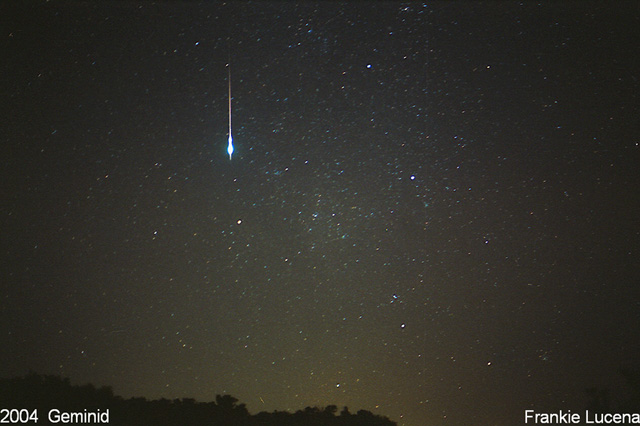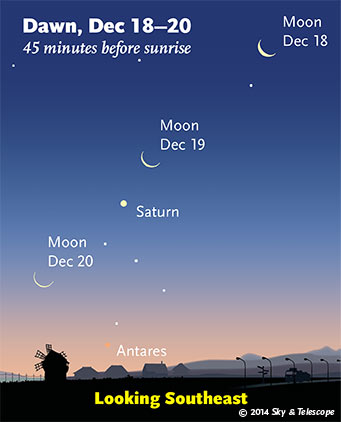Some daily sky sights among the ever-changing Moon, planets, and stars.
Friday, December 12
This is the time of year when, around 8 or 9 p.m., Cassiopeia stands very high in the north as a flattened letter M. When will you see it perfectly level? This mostly depends on how far east or west you are in your time zone.

Saturday, December 13
The Geminid meteor shower should be at its strongest late tonight and late tomorrow night. Bundle up even more warmly than you think you'll need, find a dark, shadowed site with an open view overhead, lie back in a reclining lawn chair, and watch the stars. Be patient.
Under a fairly dark sky you may see a meteor every minute or two. You know it's a Geminid if its path, traced far enough backward across the sky, would pass close to Castor and Pollux in Gemini. The Moon, at last quarter, rises around 11 or midnight depending on your location, brightening the sky somewhat. See article.
Sunday, December 14
The Geminid meteors late tonight should still be near maximum activity; see above. The Moon rises an hour later than it did last night at your location.
Monday, December 15
Double shadow transit on Jupiter! Both Io and Europa are casting their tiny black shadows onto the face of Jupiter from 1:12 to 2:02 a.m. Tuesday morning Eastern Standard Time (10:12 to 11:02 p.m. Monday evening Pacific Standard Time).
Europa itself starts crossing Jupiter at 1:18 a.m. EST, and Europa starts crossing the disk at 2:15 a.m. EST. For all about the doings on and around Jupiter for amateur telescopes this month, see "Action at Jupiter" in the December Sky & Telescope, page 52.
Algol is near its minimum light this evening, magnitude 3.4 instead of its usual 2.1, for a couple hours centered on 10:22 p.m. EST (7:22 p.m. PST). It takes several additional hours to fade and to rebrighten. Comparison-star chart.
Tuesday, December 16
Maybe you're familiar with the ET Cluster, NGC 457 in Cassiopeia. But what about its neighbor Sharpless 2-173, a faint nebula containing the weak cluster Mayer 1? Use the Queen's Kite asterism to get there, as Sue French shows in her Deep-Sky Wonders chart and column in the December Sky & Telescope, page 56.

Wednesday, December 17
Having trouble spotting Saturn in the dawn? On Thursday morning the 18th the waning Moon points down to the spot, as shown here.
Thursday, December 18
On Friday morning the 19th the Moon hangs closer over Saturn, as shown here.
Algol is near its minimum light for a couple hours centered on 7:12 p.m. EST Thursday evening.
Friday, December 19
Have you ever tried to catch Sirius actually rising? If you can find a good view down to the east-southeast horizon, watch for Sirius emerging about two fists at arm's length below Orion's Belt. It now rises sometime around 7:30 or 8 p.m. local time, depending on your location. When a star is very low, it tends to twinkle quite slowly and often in vivid colors. Sirius is bright enough to show these effects well.
Saturday, December 20
You are remembered, Carl Sagan (November 9, 1934 – December 20, 1996).
A deep mutual eclipse among Jupiter's moons! Callisto will cast its shadow onto Io from 10:13 to 10:32 p.m. Eastern Standard Time. At mid-eclipse, Io should be dimmed by a very noticeable 1.1 magnitude. Compare it carefully with the brightnesses of Jupiter's other moons. Io will appear just to Jupiter's east quite close to Ganymede, which is normally only 0.4 magnitude brighter. Dimmer Callisto will be just a little farther east.
The timing of this is excellent for observers in Europe, though you'll have to go out very late; add 5 hours to the times above to get UT. The timing is fair for North America's East Coast, where Jupiter will be rather low in the east. Westerners miss this one.
________________________________
Want to become a better astronomer? Learn your way around the constellations. They're the key to locating everything fainter and deeper to hunt with binoculars or a telescope.
This is an outdoor nature hobby; for an easy-to-use constellation guide covering the whole evening sky, use the big monthly map in the center of each issue of Sky & Telescope, the essential guide to astronomy. Or download our free Getting Started in Astronomy booklet (which only has bimonthly maps).

Once you get a telescope, to put it to good use you'll need a detailed, large-scale sky atlas (set of charts). The standards are the little Pocket Sky Atlas, which shows stars to magnitude 7.6; the larger and deeper Sky Atlas 2000.0 (stars to magnitude 8.5); and once you know your way around, the even larger Uranometria 2000.0 (stars to magnitude 9.75). And read how to use sky charts with a telescope.
You'll also want a good deep-sky guidebook, such as Sue French's Deep-Sky Wonders collection (which includes its own charts), Sky Atlas 2000.0 Companion by Strong and Sinnott, the bigger Night Sky Observer's Guide by Kepple and Sanner, or the beloved if dated Burnham's Celestial Handbook.
Can a computerized telescope replace charts? Not for beginners, I don't think, and not on mounts and tripods that are less than top-quality mechanically (able to point with better than 0.2° repeatability, which means fairly heavy and expensive). As Terence Dickinson and Alan Dyer say in their Backyard Astronomer's Guide, "A full appreciation of the universe cannot come without developing the skills to find things in the sky and understanding how the sky works. This knowledge comes only by spending time under the stars with star maps in hand."
This Week's Planet Roundup
Mercury is hidden in the glare of the Sun.
Venus (magnitude –3.9) is beginning to show through the glow of sunset. Look for it just above the southwest horizon 20 or 30 minutes after sundown. The farther south you live the higher it will appear. See Bob King's Venus Finally Comes Out of Hiding.
Mars (magnitude +1.0, in Capricornus) still glows in the southwest during and after twilight. And it still sets around 8 p.m. local time.
Jupiter (magnitude –2.3, in western Leo) rises in the east-northeast around 9 or 10 p.m. About 40 minutes later, fainter Regulus (magnitude +1.4) rises below it. By dawn they shine high in the southwest — with Regulus now to Jupiter's left.
Saturn (magnitude +0.5, between Libra and Scorpius) is emerging into the dawn sky. During early dawn look for it low in the southeast, far below Arcturus.
Uranus (magnitude 5.8, in Pisces) and Neptune (magnitude 7.9, in Aquarius) are still well up in the southern sky right after dark. Use binoculars or a small telescope and our finder charts for Uranus and Neptune.
__________________________
All descriptions that relate to your horizon — including the words up, down, right, and left — are written for the world's mid-northern latitudes. Descriptions that also depend on longitude (mainly Moon positions) are for North America.
Eastern Standard Time (EST) is Universal Time (UT, UTC, or GMT) minus 5 hours.
"Imagination will often carry us to worlds that never were. But without it we go nowhere."
— Carl Sagan
 0
0
Comments
You must be logged in to post a comment.